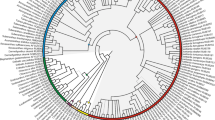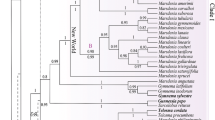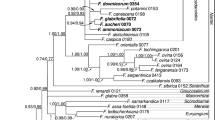Abstract
Jarava, a genus of the tribe Stipeae with 31 American species, is considered polyphyletic. In previous phylogenetic analyses, despite a few species of Jarava were used, they were included in the Major American Clade (MAC) together with species of Achnatherum, Amelichloa and Nassella. The main goal of this study is to test the monophyly of Jarava and to estimate relationships of Jarava species and allied genera. Eighty-nine species of Stipeae (17 species of Jarava) were included in the analyses of trnH-psbA and ITS regions from plastid and nuclear genomes, respectively. Morphological characters were optimized on one of the shortest trees derived from the combined analysis. Jarava splits into different lineages. Jarava ichu, the type species of the genus, and other eight species of Jarava were grouped into subclade B; another four species were associated with Achnatherum in subclade A. Both subclades A and B were included into the MAC. Three species: Jarava neaei, J. psylantha, and J. subplumosa, were grouped with Pappostipa in subclade C. The close relationship between Jarava and Pappostipa appears as a novelty and they should be considered within this genus or recognized as a new genus sister to Pappostipa. The awn indumentum (hair length and position of long hairs, either in part or the entire awn) and the subacute or acute callus are useful to recognize the group (subclade C). Geographical distribution of Jarava from subclade C overlaps completely with that of Pappostipa. The shared geographical distribution is in accordance with major groupings in our phylogenetic topology.








Similar content being viewed by others
References
Arriaga MO (2007) Jarava. In: Barkworth ME, Capels KM, Long S, Anderton LK, Piep MB (eds) Flora of North America, vol 24. Oxford University Press, Oxford, pp 178–181
Arriaga MO, Barkworth ME (2006) Amelichloa: a new genus in the Stipeae (Poaceae). Sida 22:145–149
Barkworth ME (1990) Nassella (Gramineae, Stipeae): revised interpretation and nomenclatural changes. Taxon 39:97–614
Barkworth ME (1993) North American Stipeae (Gramineae): taxonomic changes and other comments. Phytologia 74:1–25
Barkworth ME (2007) Achnatherum, modified by Barkworth ME from Barkworth ME, Capels KM, Long S, Anderton LK, Piep MB (eds) Flora of North America 24:114-142. http://herbarium.usu.edu/webmanual. Accessed 14 Nov 2013
Barkworth ME, Arriaga MO, Smith JF, Jacobs SW, Valdés-Reyna J, Bushman BS (2008) Molecules and morphology in South American Stipeae (Poaceae). Syst Bot 33:719–731
Bentham G (1878) Stipa Linn. In: Bentham G (ed) ‘Reprint of the first edn, Flora Australiensis 7’, p 564–571 (A. Asher & Co., Amsterdam, 1967)
Caro JA, Sanchez E (1973) Las especies de Stipa (Gramineae) del subgénero Jarava. Kurtziana 7:61–116
Cialdella AM (2012) Tribu Stipeae. In: Zuloaga FO, Rúgolo de Agrasar ZE, Anton AM (eds) Flora vascular de la República Argentina, vol 3, Tomo 2. Gráficamente Ediciones, Córdoba, p 372–495
Cialdella AM, Giussani LM, Aagesen L, Zuloaga FO, Morrone O (2007) A phylogeny of Piptochaetium (Poaceae: Pooideae: Stipeae) and related genera based on a combined analysis including trnL-F, rpl16, and morphology. Syst Bot 32:545–559
Cialdella AM, Salariato DL, Aagesen L, Giussani LM, Zuloaga FO, Morrone O (2010) Phylogeny of New World Stipeae (Poaceae): an evaluation of the monophyly of Aciachne and Amelichloa. Cladistics 26:563–578
Cialdella AM, Sede SM, Romaschenko K, Peterson PM, Soreng RJ, Zuloaga FO, Morrone O (2014) Phylogeny of Nassella (Stipeae, Pooideae, Poaceae) based on analyses of chloroplast and nuclear ribosomal DNA and morphology. Syst Bot 39:814–828
Clayton WD, Vorontsova MS, Harman KT, Williamson H (2006 onwards) GrassBase—the online world grass Flora. http://www.kew.org/data/grasses-db.html. Accessed 14 Nov 2013
Clement M, Posada D, Crandall KA (2000) TCS: a computer program to estimate gene genealogies. Molec Ecol 9:1657–1659
Doyle JJ, Doyle JL (1987) A rapid DNA isolation procedure for small quantities of fresh leaf tissue. Phytochem Bull Bot Soc Amer 19:11–15
Farris JS, Albert VA, Källersjö M, Lipscomb D, Kluge AG (1996) Parsimony jackknifing outperforms neighbor-joining. Cladistics 12:99–124
Goloboff PA (1999) Analyzing large data sets in reasonable times: solutions for composite optima. Cladistics 15:415–428
Goloboff PA, Farris JS, Nixon KC (2008) TNT: tree analysis using new technology, a free program for phylogenetic analysis. Cladistics 24:774–786
Hall TA (1999) BioEdit: a user-friendly biological sequence alignment editor and analysis program for Windows 95/98/NT. Nucl Acids Symp Ser 41:95–98
Hamasha HR, von Hagen KB, Röser M (2011) Stipa (Poaceae) and allies in the Old World: molecular phylogenetics realigns genus circumscription and gives evidence on the origin of American and Australian lineages. Pl Syst Evol 298:351–367
Jacobs SWL, Everett J (1996) Austrostipa, a new genus, and new names for Australasian species formerly included in Stipa (Gramineae). Telopea 6(4):579–595
Jacobs SWL, Everett J (1997) Jarava plumosa (Gramineae), a new combination for the species formerly known as Stipa papposa. Telopea 7(3):301–302
Jessop J (1981) Flora of central Australia. Reed, Sydney
Katoh K, Toh H (2008) Recent developments in the MAFFT multiple sequence alignment program. Brief Bioinforma 9:286–298
Korbie DJ, Darren J, Mattick JS (2008) Touchdown PCR for increased specificity and sensitivity in PCR amplification. Nat Protocols 9:1452–1456
Matthei O (1965) Estudio crítico de las gramíneas del género Stipa en Chile. Gayana Bot 13:2–137
Morrone O, Zuloaga FO, Longhi-Wagner HM, Izaguirre P, Beyhaut R, Cialdella AM, Giussani L, Denham SS, Guglieri A, Boldrini I, Zanín A, Salariato D, De Gennaro D (2008) Poaceae. In: Zuloaga FO, Morrone O, Belgrano MJ (eds) Catálogo de las Plantas Vasculares del Cono Sur (Argentina, Sur de Brasil, Chile, Paraguay y Uruguay), vol 1. Missouri Botanical Garden Press, St. Louis, pp 609–967
Müller K (2005) SeqState— primer design and sequence statistics for phylogenetic DNA data sets. Appl Bioinforma 4:65–69
Peñailillo P (2002) El género Jarava Ruiz and Pav. (Stipeae-Poaceae): delimitación y nuevas combinaciones. Gayana Bot 59:27–34
Roig FA (1972) Novedades en Stipa (Gramineae) de la Patagonia. Bol Soc Argent Bot 14:311–318
Rojas PF (1997) Nuevas especies y nuevas combinaciones para la tribu Stipeae (Poaceae) en Bolivia. Gayana Bot 54:163–182
Romaschenko K, Peterson PM, Soreng RJ, Garcia-Jacas N, Futorna O, Susanna A (2008) Molecular phylogenetic analysis of the American Stipeae (Poaceae) resolves Jarava sensu lato polyphyletic: evidence for a new genus, Pappostipa. J Bot Res Inst Texas 2:165–192
Romaschenko K, Peterson PM, Soreng RJ, Garcia-Jacas N, Susanna A (2010) Phylogenetics of Stipeae (Poaceae: Pooideae) based on plastid and nuclear DNA sequences. In: Seberg O, Petersen G, Barfod AS, Davis JI (eds) Diversity, phylogeny, and evolution in the monocotyledons. Aarhus University Press, Denmark, pp 513–539
Romaschenko K, Peterson PM, Soreng RJ, Garcia-Jacas N, Futorna O, Susanna A (2012) Systematics and evolution of the needle grasses (Poaceae: Pooideae: Stipeae) based on analysis of multiple chloroplast loci, ITS, and lemma micromorphology. Taxon 61:18–44
Ruiz H, Pavón J (1794). Florae peruvianae, et chilensis prodromus, sive novorum generum plantarum peruvianorum, et chilensium descriptiones, et icones. Imprenta de Sancha, Madrid
Shaw J, Lickey EB, Beck JT, Farmer SB, Liu W, Miller J, Siripun KC, Winder CT, Schilling EE, Small RL (2005) The tortoise and the hare II: relative utility of 21 noncoding chloroplast DNA sequences for phylogenetic analysis. Amer J Bot 92:142–166
Simmons MP, Ochoterena H (2000) Gaps as characters in sequence-based phylogenetic analyses. Syst Biol 49:369–381
Soreng RJ, Davidse G, Peterson PM, Zuloaga FO, Judziewicz EJ, Filgueiras TS, Morrone O (2003 onwards). New world grasses (Poaceae). http://www.tropicos.org/Project/CNWG. Accessed 14 Nov 2013
Spegazzini C (1901) Stipeae platenses. An Mus Nac Montev 4:1–173
Spegazzini C (1925) Stipeae platenses novae vel criticae. Revista Argent Bot 1:9–51
Steudel EG (1855) Synopsis plantarum glumacearum 1. JB Metzler, Stuttgart, p 420
Torres MA (1997) Nassella (Gramineae) del noroeste de la Argentina, Stipa (Gramineae) del noroeste de la Argentina, Nicoraella (Gramineae) un nuevo género para América del Sur. Ministerio de la producción y el empleo, provincia de Buenos Aires, Comisión de Investigaciones Científicas (CIC). Monografía 13:3–76
Trinius CB, Ruprecht FJ (1842) Species Graminum stipaceorum [preprint of “Gramina agrostidea, III. Callus obconicus, (Stipacea)”]. Mem Acad Imp Sci St Petersb, Sér 6, Sci Math, Seconde Pt Sci Nat 7(5):1–189
USDA, NRCS (2013) The Plants Database. National Plant Data Team, Greensboro, NC USA. http://plants.usda.gov. Accessed 14 Nov 2013
Valdés-Reyna J, Barkworth ME (2002) Poaceae II. Pooideae: Tribu Stipeae. Flora de Veracruz. Instituto de Ecología A C, Xalapa and University of California, Riverside. 127:1–28
Watson L, Dallwitz MJ (1992) onwards) The grass genera of the world. CAB International, Wallingford
White TJ, Bruns T, Lee S, Taylor J (1990) Amplification and direct sequencing of fungal ribosomal RNA genes for phylogenetics. In: Innis MA, Gelfand D, Sminsky J, White T (eds) PCR protocols: a guide to methods and applications. Academic Press, San Diego, pp 315–322
Zanín A, Mujica-Salles J, Longhi-Wagner HM (1992) Gramineae, tribo Stipeae. Bol Inst Bioci Univ Fed Rio Grande do Sul 51:1–174
Zhenlan W, Phillips SM (2006) Tribu Stipeae. In: Wu Z, Raven P, Hong D (eds) Flora of China 22: Poaceae. Science Press, Beijing and Missouri Botanical Garden Press, St. Louis, pp 196–211
Acknowledgments
We are indebted to our friend and colleague O. Morrone, for having proposed and supported this research. We also thank S. Denham, J. Hurst, A. Sassone, G. Oliva (EEA INTA Santa Cruz), J. J. Magaldi (AER INTA Caleta Olivia) and L. San Martino and M. Roa (AER INTA Los Antiguos) for assistance with fieldwork and the staff of the Darwinion, who kindly helped us with the plant material. We thank F. Rojas for drawings of the florets. We are grateful to the Administración de Parques Nacionales for allowing us to conduct field work in natural reserves. We thank the editor and two anonymous reviewers for their valuable suggestions and comments, which helped us to improve the manuscript.This research was supported by Consejo Nacional de Investigaciones Científicas y Técnicas (CONICET), grant PIP 11220100100155 and by Agencia Nacional de Promoción Científica y Tecnológica (ANPCyT), grant PICT 2010-1645 to O. Morrone.
Author information
Authors and Affiliations
Corresponding author
Additional information
Handling editor: Frank H. Hellwig.
Rights and permissions
About this article
Cite this article
Sclovich, S.E., Giussani, L.M., Cialdella, A.M. et al. Phylogenetic analysis of Jarava (Poaceae, Pooideae, Stipeae) and related genera: testing the value of the awn indumentum in the circumscription of Jarava . Plant Syst Evol 301, 1625–1641 (2015). https://doi.org/10.1007/s00606-014-1175-9
Received:
Accepted:
Published:
Issue Date:
DOI: https://doi.org/10.1007/s00606-014-1175-9




